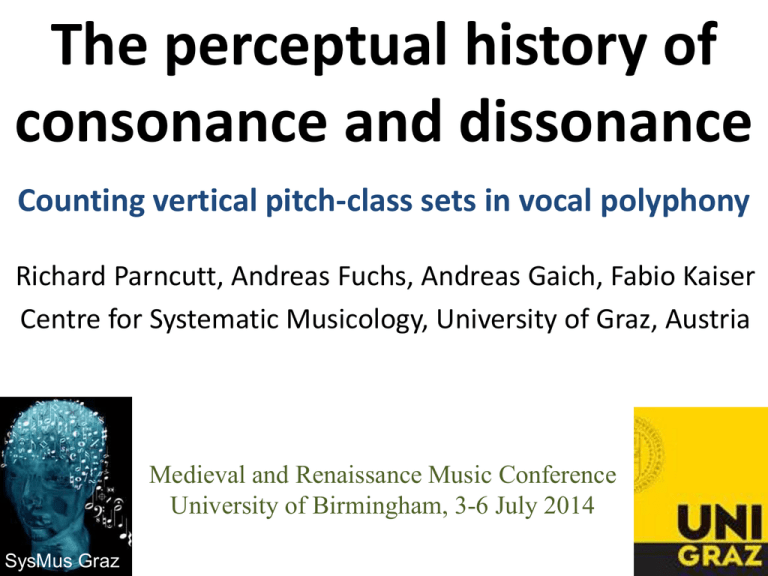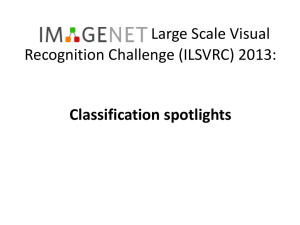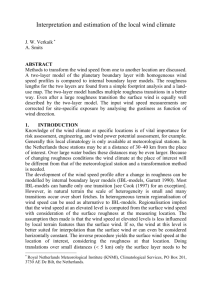C/D
advertisement

The perceptual history of consonance and dissonance Counting vertical pitch-class sets in vocal polyphony Richard Parncutt, Andreas Fuchs, Andreas Gaich, Fabio Kaiser Centre for Systematic Musicology, University of Graz, Austria Medieval and Renaissance Music Conference University of Birmingham, 3-6 July 2014 SysMus Graz Abstract How were consonance and dissonance perceived in early polyphony? We are complementing existing theory by counting vertical sets of three pitch classes. Our sample includes works attributed to Perotin, Savio, Halle (13th century); Machaut, Landini, Ciconia, Magister Andreas (14th); Dufay, Dunstable, Ockeghem, Obrecht, Isaac, Le Rouge, de Insula (15th); Lassus, Palestrina, Desprez, Byrd, Gabrieli (16th). We use electronic scores available in the internet; we have not systematically addressed ficta. With the Humdrum Toolkit we count unprepared sonorities (tones beginning simultaneously) and prepared sonorities (one or more ties). As expected, the most consonant pc-sets in the 14th-16th centuries correspond to today’s major, minor, suspended and diminished triads in that order, plus 025/035 (e.g. CDF, DFG). With time, major and minor became relatively more common. Suspended (057) and 025/035 were common in the 13th. The data allow us to test psychological models of consonance and dissonance based on smoothness (lack of beating), harmonicity (similarity to harmonic series), diatonicness (scale belongingness) and evenness (spacing around chroma cycle). All four predictions correlate with mean results for the 13th-14th century, but only roughness and harmonicity correlate with 15th and 16h separately, consistent with gradually increasingly sensitivity to roughness and harmonicity. Consonance and dissonance (C/D) in early music An interdisciplinary question! Orientation Humanities Sciences People Music history Music psychology Information Music theory Music computing Perotin: Mors “Gm/A”: unprepared! pc set: GABbD Perotin: Viderunt Omnes “Cadd9/G” pc set: CDEG Perotin: Viderunt Omnes “C7/G” – unprepared! pc set: EGBbC Alfonso el Sabio: Santa Maria, strela do dia “D7/C” – unprepared! pc set: F#ACD Alfonso el Sabio: Santa Maria, strela do dia D/E ... ??? ... E7/sus4 ... D7sus/C ... ??? pc sets: DEF#A ABD ABDE GACD EGA Dissonant sonorities in early music How should we approach them? • • • • Are pc-set labels appropriate? Are dissonances accidental or deliberate? Are they products of voice-leading rules? Should we look at individual examples or do statistics? • Is frequency of occurrence (prevalence) a useful measure of their consonance? Why do statistical analysis? Assumptions: 1. “Consonant” sonorities are more prevalent 2. Composers are more likely to “prepare” dissonant than consonant sonorities Two indirect measures of C/D Preparation of dissonance prepared unprepared less dissonant more dissonant Psychological explanations Stream segregation reduces dissonance (Wright & Bregman, 1987) Roughess depends on relative amplitude (Terhardt,1974) Pitch-class sets – Tn-types John Rahn (1980): Basic atonal theory Intervallic inversion 037= minor; 047 = major same pc-set “3-11” different Tn-types “3-11A”, “3-11B” There are… 19 Tn-sets of cardinality 3 (012, 013...) 43? Tn-sets of cardinality 4 (0123, 0124...) Familiar examples 036 = dim, 048 = aug, 027 = sus (=702=057) 025/035: no name All Tn-types of cardinality 3 What is the C/D of a Tn-set? Three approximate measures 1. Consensus among music theorists (past and present) 2. Prevalence in musical scores 3. Psychological predictions Here, we test 3 by comparing predictions with 2. Psychological theories of C/D of sonorities (vertical C/D) Familiarity Completely learned (Cazden, Krumhansl…) Roughness Peripheral (ear); innate (Helmholtz, Plomp…) Diatonicity Diatonic scale is “overlearned” (Deutsch…) Harmonicity (fusion) Central (brain); partly learned (Stumpf, Terhardt…) The interval vector Interval-based C/D models Minor and minor triads have the same interval vector: <001110> i.e. both chords have: 0 m2s, 0 M2s, 1 m3s, 1M3s, 1 P4s, 0 TTs (plus intervallic inversions) Assumption The C/D of a pc-set depends approximately on its interval vector (cf. interval-based Renaissance theory) Roughness A measure of C/D? Pc-set 012 013 014 015 016 024 025 026 027 036 037 048 Inversion 023 034 045 056 035 046 047 #semitones 2 1 1 1 1 0 0 0 0 0 0 0 #tritones 0 0 0 0 1 0 0 1 0 1 0 0 sum 2 1 1 1 2 0 0 1 0 1 0 0 C/D of interval classes convergent evidence from different sources Harmonicity A measure of C/D? Pc-set 012 013 014 015 016 024 025 026 027 036 037 048 Inversion # Fourths 023 034 045 056 0 0 0 1 0 035 046 0 1 0 047 1 0 1 0 Diatonicity A measure of C/D? Pc-set 012 013 014 015 016 024 025 026 027 036 037 048 Inversion Diatonicity 023 034 045 056 0 2 0 2 1 035 046 3 4 1 047 5 1 3 0 Possible justifications: • Notation: Practical limitations of diatonic notation system • Psychology: Deep familiarity of diatonic scale since antiquity Music database • Vocal polyphony • Mainly sacred, some secular • Mainly 4 parts; sometimes 3, 5, 6, or 8 Sources • • • • • • Kern scores CPDL (Choral Public Domain Library) Elvis (Electronic Locator of Vertical Interval Successions) PMFC (Polyphonic Music of the Fourteenth Century) musicalion.com IMSLP.org “Composers” in database 13th century Perotin (1150/65-1200/25, French) Alfonso el Sabio (1221-1284, Spanish) Adam de la Halle (1250-1310, French) Montpellier Codex (1250-1300, French) 14th century Guillaume de Machaut (1300-1377, French) Landini, Francesco (1325-1397, Italian) Johannes Ciconia (c.1335 or c.1370, French) Philippe de Vitry (1291-1361, French) Jacopo da Bologna (1340-1386, Italian) Egardus (fl. c. 1370 – after 1400, Flemish) Composers in database 15th century Guillaume Dufay (1397-1474, Franco-Flemish) John Dunstaple (1390-1453, English) Johannes Ockeghem (1410/30-1497, Franco-Flemish) Jacob Obrecht (1450-1505, Flemish) Heinrich Isaac (1450-1517, Franco-Flemish) Guillaume le Rouge (fl. 1450-1465, Netherlands) Simon de Insula (fl. c.1450-60, English or French) 16th century Orlando de Lassus (1532-1594) Giovanni Pierluigi da Palestrina (1514/15-1594) Josquin Desprez (1450/55-1521) William Byrd (1540-1623) Giovanni Gabrieli (1555-1612) Andrea Gabrieli (1532-1585) Composers in database 17th century Claudio Monteverdi (1567-1643) Heinrich Schütz (1585-1672) Adriano Banchieri (1568-1634) Girolamo Frescobaldi (1583-1643) Ruggero Giovannelli (1560-1625) 18th century Johann Joseph Fux (1660-1741) Georg Philipp Telemann (1681-1767) Johann Sebastian Bach (1685-1750) Georg Friedrich Händel (1685-1759) Giovanni Battista Pergolesi (1710-1736) Niccolo Jommelli (1714-1736) Christof Willibald Gluck (1714-1787) Carl Philipp Emanuel Bach (1714-1788) Johann Friedrich Doles (1715-1797) Joseph Haydn (1732-1809) Dmitri Stepanowitch Bortniansky (1751-1825) Wolfgang Amadeus Mozart (1756-1791) Composers in database 19th century Ludwig van Beethoven (1770-1827) Franz Schubert (1797-1828) Felix Mendelssohn Bartholdy (1809-1847) Robert Schumann (1810-1856) Charles Gounod (1818-1893) Anton Bruckner (1824-1896) Robert Lowry (1826-1899) Johannes Brahms (1833-1897) Josef Gabriel Rheinberger (1839-1901) Peter Iljitsch Tschaikowsky (1840-1893) Antonin Dvorak (1841-1904) Nikolai Rimski-Korsakow (1844-1908) 13th-C sample in database Perotin • • • • Magnum Liber Organi Viderunt omnes Sederunt Mors Montpellier Codex • • • • #66 Mater Dei – Mater Virgo – Eius #78 Dieus Mout me fet sovent fremir #158 Mal d'amors presnes m'amie #319 On parole – A Paris – Frese nouvele • #339 Alle psallite cum luya Adam de la Halle • • • • • • • • • • • • • • Fi Maris de vostre Amour Je muir je muir d'amourete Li dous regars de ma dame Hareu li maus d'amer M'ochist A dieu commant amouretes Dame or sui trais Amours et ma dame aussi Or est Baiars en la pasture Hure A jointes mains vous proi He Diex quant verrai Diex comment porroie Trop desire aveoir Bonne amourete Tant con je vivrai 14th-C sample in database Guillaume de Machaut • • • • Messe de nostre dame (Kyrie, Gloria) Hoquetus David Comment puet on mieux dire De toutes Flours Francesco Landini • • • • • • Squarcialupi Codex: madrigal Deh! dimmi tu A le sandra lo spirto Cara mi donna Quanto piu caro fay Si dolce non sono Johannes Ciconia • • • • • O felix templum jubila Petrum Marcellum venetum O Padua, sidus praeclarum Venetie mundi splendor Gloria Philippe de Vitry • • • • Lugentium siccentur Rex quem metrorum Virtutibus laudabilis Vos Qui Admiramini Gratissima virginis Magister Andreas Jacopo da Bologna • Sanctus • Aquila Altera • I Senti Za Como Larcho Damore • In Verde Prato • Gloria Egardus Solage • Fumeux fume par fumee Size of database in each century Counting “chords”: Method Database in Kern format Analyse using Humdrum Toolkit (Huron) Count Tn-types of cardinality 3 and 4 Distinguish prepared from unprepared sonorities Correlate counts with model predictions All trichords 1200-1900 “Cases“: all trichords and tetrachords Next slides: only the top ten trichords The main 10 trichords in 13th-C vocal polyphony ignoring register, “inversion”, spacing, doubling... Tn-type All tetrachords 1300-1900 “Cases”: all trichords and tetrachords Next slides: only the top ten The main tetrachords, 13th century Trichords before 1600 Trichords after 1600 Tetrachords before 1600 Tetrachords after 1600 Nb 17th-C sample is missing 1672-1700 Which is the best C/D model? • Predict C/D using different models • Compare with prevalence data • Which model performs better? • Implications for history of C/D? Which interval class determines C/D? Correlation coefficient between predictions and prevalence UNprepared trichords and tetrachords Winner: ic 1 (m2/M7) Roughness Runner-up: ic5 (P4/P5) Harmonicity Comparison of roughness models Correlation between predictions and prevalence UNprepared trichords Roughness is generally a good predictor Winner: Huron model (the added complexity helps) Comparison of roughness models Correlation between predictions and prevalence Prepared trichords Conclusion: as before Comparison of roughness models Correlation between predictions and prevalence: tetrachords Comparison of harmonicity models Correlation between predictions and prevalence UNprepared trichords Again, the more complex models are better Comparison of harmonicity models Correlation between predictions and prevalence Prepared trichords Again, the more complex models are better Comparison of pitch clarity models Correlation between predictions and prevalence: trichords All 3 measure the “peakedness” of the pc-salience profile (Parncutt, 1988). “Salience”: salience of most salient pc “Root ambiguity”: defined in Parncutt (1988) “Entropy”: equation from statistical mechanics. Comparison of pitch clarity models Correlation between predictions and prevalence: tetrachords UNprepared Prepared Comparison of best models Correlation between predictions and prevalence. trichords In 13th C, all 3 are important. Later, roughness and harmonicity are equally important; diatonicity becomes irrelevant Comparison of best models Correlation between predictions and prevalence: tetrachords More complex, here diatonicity is the best predictor. These are new calculations, we need to check them. Specific conclusions Main sonorities • 13th C prepared: 027, 037, 047, 035, 025, … 0247, 0257, 0358, 0357 • 14th-16th: more 047 and 037, less diversity • 13th…16th: More unprepared dissonances Roughness and harmonicity • Explain prevalence of triads in 13th-16th C prefer 5ths & avoid 2nds major/minor Familiarity • Moderate dissonances more common • Extreme dissonances less common General conclusions Vertical or horizontal? Prevalence of sonorities in multi-voiced western music is determined mainly by vertical C/D! not by voice-leading rules? Psychological C/D-concepts Vertical C/D is determined mainly by 3 factors: roughness, harmonicity, familiarity Future research To explain C/D, we need humanities & sciences: • history of music theory • psychological and statistical studies






